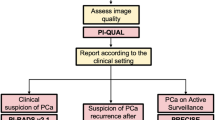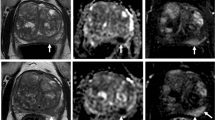Abstract
Objectives
To compare the diagnostic performance for the detection of clinically significant prostate cancer (csPCa) between bpMRI with only axial T2WI (simplified bpMRI) and standard-multiparametric MRI (mpMRI).
Methods
A total of 569 patients who underwent mpMRI followed by biopsy or prostatectomy were enrolled in this retrospective study. According to PI-RADS v2.1, three radiologists (A, B, C) from three centers blinded to clinical variables were assigned scores on lesions with simplified bpMRI and then with mpMRI 2 weeks later. Diagnostic performance of simplified bpMRI was compared with mpMRI using histopathology as reference standard.
Results
For all the three radiologists, the diagnostic sensitivity was significantly higher with mpMRI than with simplified bpMRI (P < 0.001 to P = 0.035); and although specificity was also higher with mpMRI than with simplified bpMRI for radiologist B and radiologist C, it was statistically significant only for radiologist B (P = 0.011, P = 0.359, respectively). On the contrary, for radiologist A, specificity was higher with simplified bpMRI than with mpMRI (P = 0.001). The area under the receiver operating characteristic curve (AUC) was significantly higher for mpMRI than for simplified bpMRI except for radiologist A (radiologist A: 0.903 vs 0.913, P = 0.1542; radiologist B: 0.861 vs 0.834 P = 0.0013; and radiologist C: 0.884 vs 0.848, P = 0.0003). Interobserver reliability of PI-RADS v2.1 showed good agreement for both simplified bpMRI (kappa = 0.665) and mpMRI (kappa = 0.739).
Conclusion
Although the detection of csPCa with simplified bpMRI was comparatively lower than that with mpMRI, the diagnostic performance was still high in simplified bpMRI. Our data justify using mpMRI outperforms simplified bpMRI for prostate cancer screening and imply simplified bpMRI as a potential screening tool.
Graphical abstract





Similar content being viewed by others
Abbreviations
- csPCa:
-
Clinically significant prostate cancer
- PI-RADS v2.1:
-
Prostate imaging reporting and data system version 2.1
- mpMRI:
-
Multiparametric MRI
- bpMRI:
-
Biparametric MRI
- TRUS:
-
Transrectal ultrasound
- PSA:
-
Prostate-specific antigen
- PZ:
-
Peripheral zone
- PHI:
-
Prostate health index
References
Sung H, Ferlay J, Siegel RL et al (2021) Global Cancer Statistics 2020: GLOBOCAN Estimates of Incidence and Mortality Worldwide for 36 Cancers in 185 Countries. CA Cancer J Clin 71:209-249
Udayakumar N, Porter KK (2020) How Fast Can We Go: Abbreviated Prostate MR Protocols. Curr Urol Rep 21:59
Turkbey B, Rosenkrantz AB, Haider MA et al (2019) Prostate Imaging Reporting and Data System Version 2.1: 2019 Update of Prostate Imaging Reporting and Data System Version 2. Eur Urol 76:340-351
Choi MH, Kim CK, Lee YJ, Jung SE (2019) Prebiopsy Biparametric MRI for Clinically Significant Prostate Cancer Detection With PI-RADS Version 2: A Multicenter Study. AJR Am J Roentgenol 212:839-846
Woo S, Suh CH, Kim SY, Cho JY, Kim SH, Moon MH (2018) Head-to-Head Comparison Between Biparametric and Multiparametric MRI for the Diagnosis of Prostate Cancer: A Systematic Review and Meta-Analysis. AJR Am J Roentgenol 211: W226-W241
Alabousi M, Salameh JP, Gusenbauer K et al (2019) Biparametric vs multiparametric prostate magnetic resonance imaging for the detection of prostate cancer in treatment-naïve patients: a diagnostic test accuracy systematic review and meta-analysis. BJU Int 124:209-220
Obmann VC, Pahwa S, Tabayayong W et al (2018) Diagnostic Accuracy of a Rapid Biparametric MRI Protocol for Detection of Histologically Proven Prostate Cancer. Urology 122:133-138
Scialpi M, Aisa MC, D'Andrea A, Martorana E (2018) Simplified Prostate Imaging Reporting and Data System for Biparametric Prostate MRI: A Proposal. AJR Am J Roentgenol 211:379-382
Di Campli E, Delli Pizzi A, Seccia B et al (2018) Diagnostic accuracy of biparametric vs multiparametric MRI in clinically significant prostate cancer: Comparison between readers with different experience. Eur J Radiol 101:17-23
van der Leest M, Israël B, Cornel EB et al (2019) High Diagnostic Performance of Short Magnetic Resonance Imaging Protocols for Prostate Cancer Detection in Biopsy-naïve Men: The Next Step in Magnetic Resonance Imaging Accessibility. Eur Urol 76(5):574-581
Barth BK, De Visschere PJL, Cornelius A (2017) Detection of Clinically Significant Prostate Cancer: Short Dual-Pulse Sequence versus Standard Multiparametric MR Imaging-A Multireader Study. Radiology 284:725-736
Kuhl CK, Bruhn R, Krämer N, Nebelung S, Heidenreich A, Schrading S (2017) Abbreviated Biparametric Prostate MR Imaging in Men with Elevated Prostate-specific Antigen. Radiology 285(2):493-505
Scialpi M (2021) Simplified PI-RADS-based biparametric MRI: A rationale for detecting and managing prostate cancer. Clin Imaging. 80: 290-291
Brembilla G, Giganti F, Sidhu H et al (2022) Diagnostic Accuracy of Abbreviated Bi-Parametric MRI (a-bpMRI) for Prostate Cancer Detection and Screening: A Multi-Reader Study. Diagnostics (Basel) 12:231.
Tamada T, Kido A, Yamamoto A et al (2021) Comparison of Biparametric and Multiparametric MRI for Clinically Significant Prostate Cancer Detection With PI-RADS Version 2.1. J Magn Reson Imaging 53:283-291
Görtz M, Radtke JP, Hatiboglu G et al (2021) The Value of Prostate-specific Antigen Density for Prostate Imaging-Reporting and Data System 3 Lesions on Multiparametric Magnetic Resonance Imaging: A Strategy to Avoid Unnecessary Prostate Biopsies. Eur Urol Focus 7:325-331
Wang ZB, Wei CG, Zhang YY et al (2021) The Role of PSA Density among PI-RADS v2.1 Categories to Avoid an Unnecessary Transition Zone Biopsy in Patients with PSA 4–20 ng/ml. Biomed Res Int 2021:3995789
Scialpi M, Martorana E, Scialpi P et al (2020) Roundtable: arguments in supporting abbreviated or biparametric MRI of the prostate protocol. Abdom Radiol (NY) 45:3974-3981
Park KJ, Choi SH, Lee JS, Kim JK, Kim MH (2020) Interreader Agreement with Prostate Imaging Reporting and Data System Version 2 for Prostate Cancer Detection: A Systematic Review and Meta-Analysis. J Urol 204:661-670
Brembilla G, Dell'Oglio P, Stabile A et al (2020) Interreader variability in prostate MRI reporting using Prostate Imaging Reporting and Data System version 2.1. Eur Radiol 30:3383-3392
Kohestani K, Wallström J, Dehlfors N et al (2019) Performance and inter-observer variability of prostate MRI (PI-RADS version 2) outside high-volume centres. Scand J Urol 53:304-311
Byun J, Park KJ, Kim MH, Kim JK (2020) Direct Comparison of PI-RADS Version 2 and 2.1 in Transition Zone Lesions for Detection of Prostate Cancer: Preliminary Experience. J Magn Reson Imaging 52:577-586
Tamada T, Kido A, Takeuchi M (2019) Comparison of PI-RADS version 2 and PI-RADS version 2.1 for the detection of transition zone prostate cancer. Eur J Radiol 121:108704
Funding
This study was supported by the National Key Research and Development Program of China (No. 2022YFB3203800), Innovative Research Group Project of the National Natural Science Foundation of China (Grant Nos. 82071887, 81671656).
Author information
Authors and Affiliations
Corresponding author
Ethics declarations
Conflict of interest
The authors declare no conflict of interest.
Additional information
Publisher's Note
Springer Nature remains neutral with regard to jurisdictional claims in published maps and institutional affiliations.
Rights and permissions
Springer Nature or its licensor (e.g. a society or other partner) holds exclusive rights to this article under a publishing agreement with the author(s) or other rightsholder(s); author self-archiving of the accepted manuscript version of this article is solely governed by the terms of such publishing agreement and applicable law.
About this article
Cite this article
Song, J., Zhao, C., Zhang, F. et al. The diagnostic performance in clinically significant prostate cancer with PI-RADS version 2.1: simplified bpMRI versus standard mpMRI. Abdom Radiol 48, 704–712 (2023). https://doi.org/10.1007/s00261-022-03750-8
Received:
Revised:
Accepted:
Published:
Issue Date:
DOI: https://doi.org/10.1007/s00261-022-03750-8




